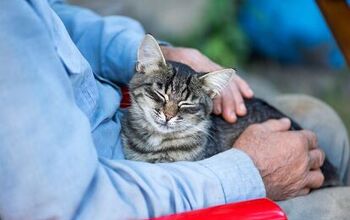How To Train A Cat To Walk On A Leash

Believe it or not, cats like to take walks with their humans too! It might sound unbelievable. Traditionally, we’ve only considered dogs to be the pet that likes to join their owner for a jaunty stroll. However, don’t forget about your cat! After all, it’s not only dogs that enjoy their time outside- kitties love being in the great outdoors. Unfortunately, the environment isn’t always so safe for cats and their free-roaming ways. This complicates things. It’s not always possible to let your cat out to have a stroll through the neighbourhood.
If you live in a high-traffic area, for instance, it’s dangerous to let your cat outside unattended. In some parts of the world, cats can be the threat themselves, hunting for already decimated wildlife, such as certain birds and small rodents. Some rural areas also have a population of animals that may treat your kitty as prey, making it far too frightening to let your cat roam around unsupervised. In any of these cases (and others), walking your cat on a leash is the perfect solution to allow your cat to have some supervised outdoor time. Regardless of your reason for wanting to walk your cat, it’s pretty obvious that you’ll be in for a challenge. This isn’t even close to the same situation as dealing with a dog.
You may have noticed that, particularly when compared to dogs, cats can be a bit stubborn. Unlike dogs that are always eager to please their owners, cats are not so eager when it comes to training. That’s not to say that you can’t teach a kitty to behave on a leash- it’s just that it usually takes a little more effort and patience. You’ll be able to pull it off, provided that you use the right approach and techniques. That’s where our experts come in. So, if you want to know how to train a cat to walk on a leash, check out the following tips to make the process easier on both you and your kitty. The two of you will be out and about in no time!
Before we get into the how-tos of leash training felines, it’s important to cover the choice of gear. After all, it’s not as if you can expect your cat to politely walk beside you without any sort of leash or harness. A safe, perfectly fitted harness and leash are a must if you want to ensure your cat’s safety while out of the house. If the leash is too loose, your cat can wiggle out of your reach with ease, and if it’s too tight, it will cause discomfort and make the training that much more difficult. Choosing the right harness is of the upmost importance to ensure that your walking training goes as smoothly as possible for you and your cat. When choosing a harness for a cat, there are a few important pointers to keep in mind.
- Different types of cat harnesses
Like any pet product, cat harnesses are available in a variety of different designs. The most popular are butterfly jackets, figure 8 cat harness, vest style harness, and a classic H harness. The design differences between these harnesses influence the ease of taking on and taking off the harness, and your cat’s Houdini tendencies should factor in the decision. You may need to experiment with a few harnesses to find the one that is the right fit for your kitty.
- Size of the harness
Cat harnesses come in different sizes. In fact, your cat might even be big enough for a small dog harness, so it’s important to measure her before buying. Using a measuring tape, see what your cat’s neck and chest girth are, and choose the harness size accordingly. You want to make sure that your cat is secure, yet comfortable. If the harness is too tight, your cat won’t ever respond well to wearing it.
- Materials
As is the case with dog harnesses, cat harnesses are also made with a variety of different materials. Some of the most common options include faux or genuine leather, nylon, and cotton. Kitties, however, seem to do best with durable nylon that gives them the comfort and safety they need when on walks. As an added bonus for their human owners, this material is easy to clean, with many of these harnesses even being machine washable. So, generally speaking, nylon is the best choice.
After you’ve purchased a feline-specific harness and leash, it’s time to introduce your cat to these new objects. This will take time and should be done over several stages.
Start by leaving them close to the cat’s food or her preferred spot to take naps. Do this for a few days so she gets used to seeing them and so she actually starts to associate them with things that bring her joy. This may sound a bit silly, but trust us, it works.
Related: Why Playtime Is So Important For Your Cat
You can also hold the leash and harness so that your pet can sniff them and become unafraid to go near them. Offering treats throughout this process is definitely helpful. It’s important to create positive associations between your kitty and the harness before trying to put it on. That way, your cat will be more likely to embrace it. Feel free to even take the training a step further by placing the harness gently on the cat’s neck, offering a treat to reward calm behavior.
Next is the challenge of getting the harness on your cat. This can be especially hard for cats that don’t like being restrained or held. To make this easier, keep the cat’s favorite snack nearby. Hold your cat gently yet firmly just for a few moments, and praise her as you do so before showing her a treat. Let her eat the treat after you let go. You’ll have to repeat this for a few days. Just be sure to always follow up the handling with the treat, holding kitty a few moments longer every time. This is a process. The payoff will be worth the long-term efforts.
Once your cat is used to the harness and she’s okay with you holding her, it’s time to begin draping it over her shoulders, down her chest, and between her front legs. Do this while rewarding her with treats, but don’t leave the harness on her at the beginning. Instead, work your way up to the point that she’s okay with you snapping the harness in place as you distract her with yummy treats. The goal is to have her completely comfortable with the sensation of the harness before ever taking her outside.
Related: 5 Helpful Cat Training Tips To Control Your Frisky Feline
Once your cat is comfortable with the harness on her body, you can adjust it so that it fits perfectly. If you can fit just two of your fingers in between her body and the harness, it’s just right. You want it to be secure but comfortable.
Start by leaving the harness on your kitty for a few minutes, and work your way up to the point that she can have it on for a long time without getting upset and without needing to be distracted by treats anymore. That said, if she does get upset at any point along the way, give her treats to make her happy as you slip off the harness. The goal is to get the harness off before she gets upset, so this can be tricky. This will take several days, so be patient. Don’t rush this process or your cat will develop an aversion to the harness.
Once ready, attach the leash to the harness and let your cat walk around as it drags on the floor. Use toys and treats to provide a distraction, and repeat this for a few days. Make sure the leash never gets caught on anything so that it doesn’t frighten her to wear the harness.
Once your cat is used to having the harness and leash on her, walk her indoors. And once you see that she’s comfortable with that, you can begin taking her for walks outside. It’s important to get your kitty completely used to walking with the harness before introducing all of the various distractions of being outdoors.
If your cat hasn’t been outside before, she’ll be startled easily and stressed out, so it’s best to start walking her in a really sheltered and quiet area like your backyard. Sit with her while the leash is on, and let her explore slowly as you follow closely. It’s important to let this part of the training play out at a pace that follows your cat’s comfort. If she has been an indoor kitty her whole life, going for a walk outside will be overwhelming. So, it’s important to approach this slowly and with care. You’ll know when your cat is comfortable and ready to move on to check out more outdoor spots.
Walking your cat is a great way to give her plenty of exercise that will help keep her in shape. The activity also reduces boredom and all of its related behavioral issues, making it a great addition to the lives of indoor kitties who have a lot of energy. Leash training will also be handy when it comes to taking your cat on trips, including trips to the veterinarian. Once your kitty gets accustomed to being outside and even starts to enjoy it, it will make required trips that much easier. We all know the pain of trying to get a cat into a carrier when they don’t want it to happen. If your kitty associates the carrier with positive experiences, then she won’t be nearly as resistant.
It’s important to be patient throughout the journey, and even learn to enjoy it (try to think of this as an adventure, rather than a dreary training process). Remember, kittens will be easier to accept the new experience, but older kitties will need time to get over their fears. Use small, gentle steps, and make sure to reward progress along the way. Also, be sure your kitty is up-to-date on required vaccinations before venturing outside together. That’s very important to avoid any difficult situations down the road.
Remember that there is a light at the end of this tunnel. As long and tricky as this training will be, eventually you’ll be able to take your cat for walks and outdoor adventures. It will undoubtedly improve both of your lives and create an all-new opportunity to play and bond together. So, while it’s important to take this training seriously and move through it gradually, remember that this is ultimately going to be a fun pastime that you will come to enjoy. Embrace the process. The payoff is worth it!
We are committed to finding, researching, and recommending the best products. We earn commissions from purchases you make using the retail links in our product reviews. Learn more about how this works.

Lisa Selvaggio is a freelance writer and editor, and our resident cats-pert, with certifications in pet nutrition and pet first aid. She enjoys producing content that helps people understand animals better so they can give their pets a safe and happy home.
More by Lisa Selvaggio























